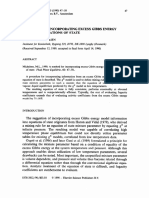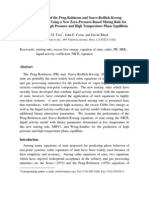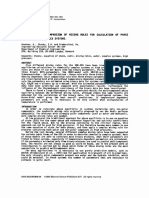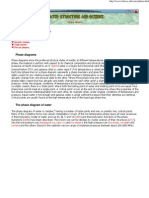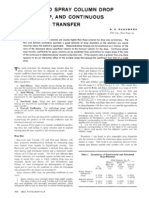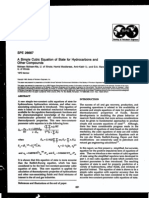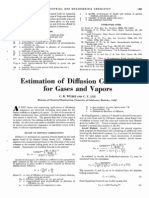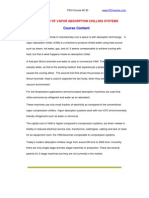Correlating Equations For Laminar and Turbulent Free Conve
Correlating Equations For Laminar and Turbulent Free Conve
Uploaded by
arman_1287Copyright:
Available Formats
Correlating Equations For Laminar and Turbulent Free Conve
Correlating Equations For Laminar and Turbulent Free Conve
Uploaded by
arman_1287Original Description:
Original Title
Copyright
Available Formats
Share this document
Did you find this document useful?
Is this content inappropriate?
Copyright:
Available Formats
Correlating Equations For Laminar and Turbulent Free Conve
Correlating Equations For Laminar and Turbulent Free Conve
Uploaded by
arman_1287Copyright:
Available Formats
Inr. J. Heal Moss Transfer.
Vol. 18, pp. 1323-1329.
Pergamon Press 1975.
Printed in Great Britam
CORRELATING
EQUATIONS
FOR
LAMINAR AND TURBULENT
FREE CONVECTION
FROM A VERTICAL
PLATE
STUART W. CHURCHILL and HUMBERT H. S. CHU
Department of Chemical and Biochemical Engineering, University of Pennsylvania,
Philadelphia, PA 19174, U.S.A.
(Received 2 August 1974 and in revised form 10 February 1975)
Abstract-A simple expression is developed for the space-mean Nu (or Sh) for all Ra and Pr (or SC)
in terms of the model of Churchill and Usagi. The development utilizes experimental values for Ra
approaching zero and infinity, and the theoretical solutions obtained from laminar boundary-layer
theory. The expression is applicable to uniform heating as well as to uniform wall temperature and for
mass transfer and simultaneous heat and mass transfer. The correlation provides a basis for estimating
transfer rates for non-Newtonian fluids and for inclined plates. Even simpler expressions are developed
for restricted ranges ofconditions. The general and restricted expressions are compared with representative
experimental data. The structure of the correlating equation shows why the common power-law-type
equations cannot be successful over an extended range of Ra and Pr.
NOMENCLATURE
arbitrary exponent;
dimensionless coefficient ;
arbitrary exponent;
b,
dimensionless coefficient ;
c,
diffusivity [m/s];
fiPrj,
dimensionless function of Pr in
equation (2);
F{m}, dimensionless function of power-law
coefficient in equation (16);
acceleration due to gravity [m/s];
local heat-transfer coefficient [J/m* . s . K];
mean heat-transfer coefficient over O-z
[J/m. s K];
thermal conductivity [J/m. s . K] ;
k,
local mass-transfer coefficient [s-l];
k,
I;, mean mass-transfer coefficient over O-z
a,
A,
m,
6
NU
NU,
Pr,
47
Ra,
Ra,
Ra*,
SC,
Sh,
sil,
T,
x,
Y*
z.
[s-l];
coefficient defined by equation (15)
[kg/m-s2-m];
exponent defined by equation (15);
exponent in equation (1);
hz/k, local Nusselt number at z;
AZ/k, mean Nusselt number over O-z;
v/u, Prandtl number;
heat flux density [J/m*-s];
g/?( T, - Tb)z3/va, Rayleigh number;
gy(o, - wb)z3/v~, Rayleigh number for mass
transfer;
gfiqz4/kvu, modified Rayleigh number based
on heat flux density;
v/g, Schmidt number;
kz/s, local Sherwood number;
IEz/g, mean Sherwood number over O-z;
temperature [K];
independent variable [m];
dependent variable [ml;
distance up plate [m].
Greek symbols
thermal diffusivity [m*/s];
thermal coefficient of expansion [K-l];
dimensionless coefficient for expansion due
to change in composition;
mass fraction;
a,
kinematic viscosity [m*/s];
v,
cp{Pr},
dimensionless function of Pr in
equation (8);
angle of inclination of the plate from the
8,
vertical;
shear stress [kgjm-s*].
7,
a,
P,
Y?
Subscripts
b,
s,
0,
00,
bulk;
surface;
limiting behavior
limiting behavior
for small z;
for large z.
INTRODUCTION
A VARIETY of theoretical expressions, graphical correlations and empirical equations have been developed
to represent the coefficients for heat and mass transfer
by free convection from vertical plates. However, the
discrepancies
between the expressions proposed
for
correlation and the various sets of experimental data
have still not been completely resolved or explained.
The experimental anomalies are apparently due in part
to physical property variations and undefined differences in the environment.
The theoretical results are
mostly limited to the intermediate range of Rayleigh
number for which the postulates of laminar boundarylayer theory are applicable; a completely satisfactory
theory has not been developed for either the diffusive
regime (low Rayleigh numbers) or the turbulent regime
(high Rayleigh numbers). The primary shortcoming of
the empirical correlations is their failure to take into
1323
1324
STLIART
W. CHURCHILL
and
proper account the uarying dependence on the Rayleigh
and Prandtl (or Schmidt) numbers.
This paper presents simple but very general correlations for the space-mean value of the transfer rate
for free convection. The correlations are developed
wholly in terms of the model of Churchill and
Usagi [lf:
.1?{r3= y;(z) -t.y; {Zi
REGIME
(2)
where f{Pr) represents a tabulation of values such as
those summarized by Ede [2] for a number of values
of Pr. Churchill and Usagi [I] derived an empirical
expression in the form of equation (1) to provide a
continuous approximation for these tabulated values
ofj{Prj. This expression can be rewritten as follows
in terms of 2JE;:
?& = 06QR~~/[l
f (@492/P@ 1 419.
indicates that n = 1 is a reasonable choice, yielding
Equation (5) is seen in Fig. 1 to provide a good
representatjon for all Ra < IO9 while equation (3) is
seen to be increasingly in error for Ra < 10.
LAMINAR
PLUS TUR~~L~~
REGIME
An asymptotic solution is not available for Ra -+ m,
but Churchill [14] has asserted on the basis of dimensional analysis that
Nu -+ ARa3cp{Prj
(31
Equation (3) represents the various computed values
within 1 per cent from Pr = 0 to Pr = cc and is in
general agreement for lo5 < Ra < 10 with the widely
scattered experimental values compiled by Ede [2].
Equation (2) and hence equation (3) would be
expected to become invalid for Ra > 15 owing to the
onset of turbulence and as Ra -+ 0 owing to thickening
of the bounda~ layer relative to the distance from the
starting edge of the plate. A generally accepted solution
has not been derived for this latter regime. For pure
conduction (Ra = 0) from an infinite
strip % = 0, but
for a plate of finite dimensions Nu has a finite value.
The experimental data of Saunders [S] indicate a hmiting value of approximately 068, probably due to edge
effects.
Utilizing 068 for yo {z>and the right side of equation
(3) for yrn{zl in equation (1) yields the following test
expression for the entire laminar regime:
A test plot of representative experimental data [2-131
in the form proposed by Churchiil and Usagi [I]
(6)
where A is an empirical constant and qo(Pri is a
function which approaches unity for Pr -+ cx) and is
proportional to Pr113 for Pr -+ 0. Equations (5) and (6)
could be combined in the form ofequation (If to obtain
a test expression for ail Ra and Pr. However the
limiting value of @68 proves to combine with equation
(6) to produce a simpler and equally successful correlation. The resulting test expression is
X? = Q68+ [ARa3yljPr)].
Boundary-layer theory has been utilized to derive
relationships of the form:
Nu = Ra4f{Prj
H.S.Cw
(11
and thus require appropriate expressions for the iimiting behavior for both large and small values of the
independent variable a.
Ede [Z] provides a thorough review of the literature
for heat transfer through 1964. In the interest of brevity,
correlations, theoretical solutions and experimental
data since that date will not be reviewed or analyzed
except insofar as they are directly relevant to the
derivations herein. The correlation is first developed
in terms of heat transfer from an isothermal plate.
Uniform heating, mass transfer, simultaneous heat and
mass transfer, non-Newtonian fluids and inclined plates
are subsequently considered.
LAMINAR
HUMBERT
(71
Equation (7) provides a dependence of Nu on Ra for
any positive ~rlwhich increases continuously from the
zeroth power to the l/3-power as Ra increases. If
equation (7) is to provide the same interrelationship
between Ra and Pr in the laminar ~u~dary-layer
regime as equation (5) it is necessary that:
pp(Pr) = f[l ~(Q492/Pr)p!]-4~P)4:3
= El~(o.492iiPrr9!16]-16!27
(8)
The expression resuhing from insertion of equation (8)
in (7) also conforms to the asserted dependence for
Pr*Oand
ao asRa-+E.
Bosworth [15) proposed an equation of the form of
equation (7) with q{Pr} = 1.0 and n = l/2 for % for
free convection from horizontal cylinders in air. Trial
plots indicate that n = l/2 is a reasonable choice for
the vertical plate as welt. The straight line with a slope
of t/6 drawn in Fig. 2 through the same representative
data as in Fig. I yields a value of A = 0.150 and hence
the final correlation:
This vafue of A is in reasonable accord with the value
of AqofPr) = 0.10, hence A = 0.12, derived by Bayiey
[16] for air and also with the value of 0.13 proposed
by Kutateladze [17] for a correlation in the form of
equation (6) for turbulent free convection from vertical
plates, cylinders and spheres to a number of fluids.
Equations (3) and (5) are plotted also in Fig. 2 for
comparison and to indicate their limits of applicability.
The undoubted superiority of equation (9) for Ra 3 199
is somewhat obscured by the lack of data for truty high
Ra, the scatter of the availabie data and the very condensed scale of the ordinate
1325
Laminar and turbulent free convection from a vertical plate
Fb/
[ i+D49el*)
9A6
16/9
FIG. 1. Correlating equations for the laminar regime of isothermal, vertical plates.
. WeIke. T0bl.m
B Elrenberg
(mars tr(ln~e,l
10-3
lo-
00
IO2
IO3
04
I03
Pa/
C ,+lO492/Al
id
9/K
107
I09
109
100
IO
IO2
16/9
FIG. 2. Comparison of correlating equations with experimental data for isothermal, vertical plates.
INTERPRETATION
Computed
values of f{ Pr} and cp{Pr} for representative fluids are given in Table 1. The significant
deviations for air and water from the limiting dependence for Pr + cc indicate why the customary empirical equations of the form of equation (2) with
f(Pr} = 1.0 and equation (6) with cp{Pr} = 1.0 have
not proven satisfactory for a variety of fluids with a
wide range of Pr. Table 1 also indicates that somewhat lesser but still significant discrepancies are to be
expected with the simplified correlations for liquid
metals based on the limiting form for Pr + 0. A
further variation in the dependence on Pr and Ra arises
from the additive constant in equations (5) and (9).
Thus empirical correlations of the form:
Nu = CRaP@
(10)
cannot be expected to be successful over an extended
range of Ra or Pr. Instead, the deviations from the
correlations in the literature must be due in part to
the choice of tb:- form rather ths.n wholly to experimental error. Such correlations appear to have outlived
their usefulness.
Equation (9) provides a smooth transition from the
laminar to the turbulent regime whereas the actual
transition is known to be essentially discrete. The
representation provided by equation (9) for this region
is thus an oversimplification of reality and is numerically successful only because the effect of the transition
is dampened by the integration which leads from the
local to the mean Nusselt number. A correlation for
the local Nusselt number extending through the transition from laminar to turbulent motion would need to
be more complicated in structure than equation (9).
1326
STUART
W.
CHURCHILL
and
HUMBERT H. S. CHU
Table 1. Correction factor for various fluids from asymptotic behavior
Go
7.0
0.70
0,024
0.004
oil
water
air
mercury,
50F
sodium,
1200F
cp{Prl
(0.492:Pr) 14.f(Pr)
1.000
0.978
0.9 14
0766
0,436
1,000
0.971
0.887
0.701
0,331
0,259
0.47 I
0.702
0.928
0.165
0366
0.623
0,905
0.292
0.194
0,912
0.962
1,000
1~000
For large temperature
differences such that the
physical properties vary significantly, Ede [2] recommends that the physical properties be evaluated at the
mean of the surface and the bulk temperature.
Wylie
[18] provides more detailed theoretical guidance for
the laminar boundary-layer
regime.
UNIFORM
HEAT FLUX
The definition of the mean Nusselt number for
uniform heating is somewhat
arbitrary.
However,
Sparrow and Gregg [ 191 have shown that for a laminar
boundary layer the use of the temperature
difference
at the midpoint of the plate yields values in better
agreement with those for uniform wall temperature
than the use of either the integrated mean temperature
difference or the integrated
mean heat-transfer
coefficient. With this definition the following expression
can be derived from the empirical representation
of
Churchill and Ozoe [20] for the local heat-transfer
coefficient for uniform heating in a laminar boundary
layer.
?i&i = 0.670Ra!4/[1 + (0.437/Pr)g6]4!g.
(11)
It may be noted that for Pr + co the coefficient of the
Rayleigh number is indeed the same as that of equation
(3) and that these expressions
differ only by
((0.492/0.437)/4- 1)lOO = 3 per cent even for Pr + 0.
[Equation (11) can be converted to one for the integrated mean temperature difference by multiplying the
coefficient 0.670 by (6/5)/2! giving 0.708 and to the
one for the integrated mean heat-transfer coefficient by
multiplying by (5/4)514/214 giving 0.745.1
Neither experimental
data nor theoretical
results
appear to provide a limiting value of Nu for Ra + 0.
Hence the same value as for uniform wall temperature
will arbitrarily be used. The exponent in equation (1)
has generally been found to be the same for similar
processes as illustrated by comparison of equations (3)
and (11). Hence in the absence of experimental
data
the following expression is proposed for the entire
laminar regime with uniform heating :
N = 06*+ [1
0670Ra4
+
(o.437/pr)W6]W
(12)
An equation of the form of equation (6) would be
expected to hold for uniform heating as well as uniform
wall temperature.
Combining
equation
(6) with
(0,492/Pr)3q{Pr)
NuO = 0.68, forcing the same relationship between Ra
and Pr as in equation (11) and assuming that l/2 is
again a satisfactory choice for n results in :
A/2Ra!6
NU12
= o825
+
[l
+(o.437/pr)9!16]8/27
(13)
A plot of a random selection from the limited sets of
experimental
data for uniform heating [21-241, in
Fig. 3 in the form suggested by equation (13) again
yields a value of A = 0.15, producing the following
correlation for uniform heating for all Ra and Pr :
NU2 = 0.825 +.
0.387Ra!
[I + (0.437/pr)W6]8/27
(14)
Churchill
[14] has asserted
that Nu for fully
developed turbulent motion (Ra -+ CD) should be the
same for uniform heating as for wall temperature if a
value independent
of z, corresponding
to a proportionality of Nu to Ra I3 is attained. This assertion
is tested by plotting equation (9) for Pr = 0.70 in Fig. 3.
Good agreement with the data may be noted as would
be expected since equations (9) and (14) differ only
slightly in one coefficient.
Free convection with uniform heating is often correlated in terms of Ra* in order to avoid explicit
inclusion of the surface temperature.
Equations (ll),
(12) and (14) can be rewritten in terms of Ra* simply
by replacing T, - Tb with q/h, hence Ra with Ra*/Nu.
However, this re-expression
disguises the important
result that the dependence of Nu on Ra is essentially
the same as for uniform wall temperature.
INCLINED
SURFACES
Vliet [25] has reviewed prior results for inclined
surfaces and presented additional results for uniform
heating. He concludes that for the laminar regime the
solutions and correlations for a vertical plate may be
used for a plate inclined up to at least 60 from the
vertical if the component
of gravity parallel to the
surface is used in the Rayleigh number. However, the
Rayleigh number for transition from laminar to turbulent motion is decreased drastically as the angle of
inclination from the vertical is increased and his local
results for the turbulent regime were better correlated
in terms of g than in terms of g sin cp,
1327
Laminar and turbulent free convection from a vertical plate
i
16'
!OO
IO4
IO
IO2
IO'
IO5
Ro,
l+oG-/P,,
IO6
946
IO'
IO9
IO9
10'0
IO
160
FIG. 3. Comparison of correlating equations with experimental data for uniformly heated, vertical plates.
MASSTRANSFER
Equations (5) and (9) with % substituted for Nu,
SC for Pr, and Ra for Ra are expected to hold for
mass transfer as long as the net rate of mass transfer
is not so high as to affect the velocity field significantly.
Representative mass-transfer data [26] are included in
Fig. 2 and reasonable agreement with equations (5) and
(9) is apparent.
(9) with cp{Pr} = 1 should be applicable for such fluids
if (p/l(T,- ~)zzm+1/Kam)413m+1is susbsituted for Ra.
Fujii et al. [33] have obtained numerical solutions
for a Sutterby fluid at finite Pr, and experimental results
for aqueous solutions of polyethylene oxide. Their
results indicate that Acrivos solution may be a reasonable approximation for real fluids if the coefficients K
and m are evaluated at the shear stress at the midheight
of the heated plate.
SIMULTANEOUSHEAT AND MASSTRANSFER
On the basis of the results of Saville and Churchill
[27] and Lightfoot [28] for mass transfer due to a
temperature gradient only (a(ws-wb)/fl( T, -- &) + 0
and Pr/Sc -+ 0) % can be substituted for Nu and
Ra(Sc/Pr)43 for Ra in equation (9).
Also, on the basis of the results of Saville and
Churchill [27] for simultaneous heat and mass transfer,
Nu and Sh can be calculated from equation (9) for the
special case of SC = Pr merely by substituting Ra + Ra
for Ra. For SC # Pr, the asymptotic solutions are not
explicit and simple substitution in equation (9) is not
possible [29].
NON-NEWTONIANFLUIDS
For a power-law fluid such that:
t=-K-
du m-1 du
-.
dy
II
dy
Acrivos [30] has derived for Pr + co the following
generalized form of equation (2):
Zmfl
Nu = F{M}
l/(3,+1)
>
(16)
where F {m>is a weak function of m and F {l.O} = @670.
Equation (16) has been confirmed as a good representation for a number of fluids with 0.6 < m < 1.0
by Agarwal et al. [30] for uniform wall temperature,
and the analogue of equation (16) for uniform heating
with 0.4 < M < 1.0 by Chen and Wollersheim [32]. It
follows that equation (5) with f{Pr} = 1 and equation
CONCLUSIONS
1. Equation (9) based on the model of Churchill and
Usagi provides a good representation for the mean
heat transfer for free convection from an isothermal
vertical plate over a complete range of Ra and Pr from
0 to 00 even though it fails to indicate a discrete
transition from laminar to turbulent flow.
2. Equation (14) provides an equivalent representation for heat transfer by free convection from a
uniformly heated vertical plate. However, equation (9)
is also an adequate representation for this boundary
condition.
3. Equation (9) is applicable to mass transfer with
a, Ra and SC substituted for Nu, Ra and Pr and can
be applied for simultaneous heat and mass transfer for
the special case of Pr = SC if Ra+ Ra is substituted
for Ra. Other such extensions are also possible.
4. More accurate representations for the laminar
regime are provided by equations (5) and (12) and these
simpler expressions should be used rather than equations (9) and (14) for Ra < 109. The expressions for the
laminar regime are also applicable to mass transfer
and simultaneous heat and mass transfer with the
indicated substitutions.
5. Equations (5) and (12) are proposed as tentative
representations for laminar convection from plates
inclined up to at least 60 from the vertical if gsincp
is substituted for g. Based on the results of Vliet [25],
equations (9) and (14) may be applicable for the turbulent regime without this modification. Fortunately
1328
STUART
W. CHURCHILL and
these equations are quite insensitive to the point of
transition from laminar to turbulent motion.
6. Equations (9) with Pr -+ cg is applicable to nonNewtonian fluids whose behavior can be represented
by a power-law
if (pg~(T,-~)~~~+~l<~l~)~~~~
is
used for Ra.
7. The principal uncertainty in the correlations proposed herein arises from the uncertainty in the limiting
solutions and experimental data for Ru -+ 0 and a.
8. General correlations of the simple power-law type
such as equation (10) are seen to be fundamentally
unsound for any extended range of the variables and
their use is no longer justified.
REFERENCES
1. S. W. Churchill and R. Usagi, A general expression for
2.
3.
4.
5.
6.
7.
8.
9.
10.
11.
12.
13.
14.
the correlation ofrates of transfer and other phenomena,
A.1.Ch.E. JI 18, 1121-1128 (1972).
A. J. Ede, Advances in free convection, in Advances in
Heat Transfer, edited by J. P. Hartnett and T. F. Irvine,
Jr., Vol. 4, pp. l-64. Academic Press, New York (1967).
0. A. Saunders, Effect of pressure upon natural convection in air, Proc. R. Sot. A157,278-291 (1936).
E. Griffiths and A. H. Davis, The transmission of heat
by radiation and convection, DSIR Special Report
No. 9, His Majestys Stationary Office, London (1922).
W. J. King, The basic laws andhata of heat transmission
free convection. Mech. Enana 54. 347-353 (1932).
E. Schmidt and W. Beckmann,Das Tempera&- und
Geschwindigkeitsfeld vor einer Wlrme abgebenden
senkrechten Platte bei nattirlichen Konvektion, Tech.
Mech. Thermo-dynam, Berlin 1, 341, 391 (1930).
N. H. Lorenz, Die Warmeiibertragung von einer ebenen
senkrechten Platte an 01 bei natiirlichen Konvektion,
2. Tech. Phys. 15, 362-366 (1934).
R. Cheesewright, Turbulent natural convection from a
vertical plane surface, J. Heat Transfer 9OC, l-8 (1968).
Y. S. Touloukian, G. A. Hawkins and M. Jakob, Heat
transfer by free convection from heated vertical surfaces
to fluids. Trans. Am. Sot. Mech. Enars 70. 13-23 (1948).
T. Fujii, Experimental studies of f;ee convection heat
transfer, Bull. J.S.M.E. 2(8), 555-558 (1959).
M. Jakob, Data as reported in Ede [2] above.
C. Y. Warner and V. S. Arpaci, An experimental investigation of turbulent natural convection at low pressure
along a vertical heated flat plate, Int. d. Heat Mass
Transfer 11, 397-406 (1968).
W. P. Farmer and W. T. McKie, Natural convection
from a vertical isothermal surface in oil, ASME Paper
64-WA/HT-12 (1964).
S. W. Churchill, An analysis of heat and component
transfer by turbulent free convection from a vertical
plate, Proc. Chemeca 70, Session 6A, pp. 1-16.
Butterworths of Australia, Sydney (1970).
HUMBERT H. S. CHU
15. R. L. C. Bosworth, Heat Transfer Phenomena, p. 101.
Wiley, New York (1952).
16. F. .I. Bayley, An analysis of turbulent free convection
heat transfer, Proc. Instn Mech. Engrs 169(20), 361-370
(1955)
17, S. S. Kutateladze, Fundamentals of Heat Transfer,
p. 294. Edward Arnold, London (1963).
18. R. G. Wylie, The transfer coefficients of a laminar
boundary layer with variable fluid properties, Chem.
Engng 6, l-14 (1973).
19. E. M. Sparrow and J. L. Gregg, Laminar free convection
from a vertical plate with uniform surface heat flux,
\----I.
Trans. Am. Sac. Mech. Engrs 78,435-440
(1956).
20. S. W. Churchill and H. Ozoe, A correlation for iaminar
free convection from a vertical plate, J. Heat Transfer
95c, 540-541
(1973).
21. J. P. Dotson, Heat transfer from a vertical plate by free
convection, MS. Thesis, Purdue University, Lafayette,
Indiana (1954).
22. G. C. Vliet and C. K. Liu, An experimental study of
turbulent natural convection boundary layers, J. Heat
Trunsfer 91C, 517-531 (1969).
23. B. H. Chang and R. G. Akins, An experimental investigation of natural convection in mercury at low Prandtl
numbers, Int. J. Heat Mass Transfer 15, 513-515 (1972).
24. D. V. Julian and R. G. Akins, Experimental investigation
of natural convection heat transfer to mercury, I/EC
Fundamentals 8,641-646
(1969).
..
25. G. C. Vliet, Natural convection local heat transter on
constant-heat-flux inclined surfaces, J. Heat Transfer
91C, 511-516 (1969).
R. Wilke. C. W. Tobias and M. Eisenberg, Free
26. C. _~
convection mass transfer at vertical plates, Chem- Engng
Prog. 49,663-674 (1953).
27. D. A. Saville and S. W. Churchill, Simultaneous heat
and mass transfer in free convection boundary layers,
A.I.Ch.E. JI 16,2688273 (1970).
28. E. N. Lightfoot, Free-convection heat transfer: The
limiting case of Gr,,/Gr + 0 and Pr/Sc -+ 0, Chem.
Engng Sci. 23,93 1 (1968).
29. J. W. Taunton, B. N. Lightfoot and W. E. Stewart,
Simultaneous heat and mass transfer in laminar boundary layers, Int. J. Heat Mass Transfer 25, 1927-1937
(1970).
30. A. Acrivos, A theoretical analysis of laminar natural
convection heat transfer to non-Newtonian
fluids,
A.1.Ch.E. JI 6, 584-590 (1960).
31. B. K. D. Agarwal, K. S. Lieu and M. Adelman, Experimental verification of Acrivos equation for laminar
natural heat convection to non-Newtonian
fluids,
Personal communication.
32. T. Y. W. Chew and D. E. Wollersheim, Free convection
at a vertical plate with uniform flux condition in nonNewtonian
power
123-124 (1973).
law fluids,
J. Heat Transfer 95C,
33. T. Fujii, 0. Mujatake, M. Fujii, H. Tanaka
Murakami, Natural convective heat transfer
vertical isothermal surface to a non-Newtonian
fluid, Int. J. Heat Mass Transfer 16, 2177-2187
LOIS DE CORRELATION EN CONVECTION NATURELLE LAMINAIRE
ET TURBULENTE SUR UNE PLAQUE VERTICALE
Resume-Une expression simple pour le nombre de Nusselt (ou de Sherwood) moyen est obtenue g Iaide
du modble de Churchill et Usagi pour tout nombre de Rayleigh et de Prandtl (ou de Schmidt). Au tours
des dheloppements il est fait usage de valeurs experimentales du nombre de Rayleigh tendant vers zero
ou vers linfini et de solutions theoriques obtenues en theorie de la couche limite laminaire. Lexpression
est applicable au transfert thermique a flux constant aussi bien qua temperature constante ainsi quau
transfert de masse et au transfert simultant de chaleur et de masse. La loi de correlation fournit une
base de calcul des taux de transfert pour des fluides non newtoniens et pour des plaques inclinbs. Des
expressions tout aussi simples sont developpees pour des domaines limit& correspondant a des conditions
particulitres. Les expressions dapplication gtntrale et dapphcation restreinte sont cornpar& aux
and K.
from a
Sutterby
(1973).
Laminar and turbulent free convection from a vertical plate
don&s experimentales representatives. La structure de lequation de correlation fait apparaitre la
raison pour laquelle les lois habituelles de type puissance ne peuvent sappliquer sur un domaine itendu
de nombres de Rayleigh et de Prandtl.
KORRELATIONEN
FUR LAMINARE UND TURBULENTE FREIE KONVEKTION
AN EINER SENKRECHTEN PLATTE
Zusammeofassung-Nach
einem Mode11 von Churchill und Usagi wurde eine einfache Beziehung fiir
mittlere N&Zahlen (oder Sh) fur alle Ra und Pr (oder SC) entwickelt. Es sind dazu experimentelle Werte
fiir Ra die gegen Null und unendlich gehen herangezogen und theoretische Losungen, wie sie aus der
Gre~schichttheorie erhalten werden. Die Beziehung ist anwendbar fur gleichf~rmige Heizung, einheitliche
Wandtemperatur, fur Stoff~~rgang und gle~c~eitigen Warme- und Stoff~berg~g. Die Korrelation
vermittelt eine Grundlage zur Bestimmung des Ubergangs bei nichtnewtonischen Fliissigkeiten und fiir
geneigte Platten. Fur bestimmte Anwendungsbereiche werden einfachere Beziehungen angegeben. Die
allgemeine Gleichung und die spezielle Beziehung werden vergliechen mit reprlsentativen experimentellen
Daten. Die Struktur der Korrelationsbeziehung gibt Aufschlug tiber das Versagen der allgemeinen
Exponential-Gleichungen fiir einen ausgedehnten Bereich von Ra und Pr.
KOPPEJDIHMOHHbIE
YPABHEHWX p;JDI OIIHCAHHX JIAMHHAPHOfi
I4
TYPBYJIEHTHOH
CBOSOJIHOH KOHBEKI&IH
OKOJIO BEPTMKAJIbHOH
IIJIACTMHbI
ffOMOwbH) Moxem
qepY@nns li Y3arK UonyseHo npoc~oe. BbrpameHEie Ens#ocpenn0 ISpOCTpaHCTBy 3HalfeHEiII WiC3Ia NU (WJIII &k) IIPH m&AX
3HWEHHlX
%iC.W Ru H Pr (Sinu
.!?C). npS BblBOAe ~C~O~b3O~~~Cb
3K~Uep~Me~T~bHble
AaHHble AJGI YHCna Ra, CTpeMKElerOCR K
Uynso ~GecKo~e~~ocT~,ua~a~nT~~ecK~e~~~eUu~,nony~eHHbieHaocwoseTeopuena~u~ap~oro
lTOI'paHWiHOI'OCJI0~.
BbIpameHHenpHMeHHMO
KC~~Y~~~MIIOCTO~HHO~OT~U~OBO~OIIOTOK~,I~OCTOSIHI-IO&i
TeMllepaTypbI CTeHKH, a TBK)Ke AJIK OUllCaHWII IIpOUeCCOB MaCCOO6MeHa
II OAHOBpeHeMHOrO
TeUnO-AM~CCOotiMeHa.Koppen~ull~AaeTB03MOWCHOCTb~aCCY~TaTbCKO~OCT~~e~HOCaBHeHbH)TOHOCKBX XWAXOCTIlX EIBCny'iae HaKJlOHHblXUnaCTHH.
AHanOWfHble,HO6onee UpOCTble BblpNKeHWI
IlOJIy'ieHbI
AJIX OrpaH~YeHHbIX .LWZUIil30HOB yCjrOBHkO&UeeIi
YaCTHbIeBblpaXeHHSl CpaBHHBS-OTCS
Ha AOCTOBepHblX 3KCUep~MeHT~bH~X
AaHHbIX. CTpyKTypa
KOpp~~U~OHHOrO
ypaB~eH~X
UO3BOEieT o6WfCeUTb
TOT @KT,
ITO'ieMy 06bIYHbIe ypaBHeHH5I THila CTeIIeHHblX 3aBACWMOCTeZt He
MoryTyCneUrHo
npeMeHaTbca npu 6onbmux
AHanasoHax 3Havemifi Ra zipr.
A~~oxauuwn-C
HeHHOrO
1329
You might also like
- CEIC2000 Exam 2016 MainDocument18 pagesCEIC2000 Exam 2016 MainMeena LochniNo ratings yet
- Michelsen (1990) - Method For Incorporating Excess Gibbs Energy Modified Eos.Document12 pagesMichelsen (1990) - Method For Incorporating Excess Gibbs Energy Modified Eos.Ariel Hernández SepúlvedaNo ratings yet
- Final Fluids ReportDocument131 pagesFinal Fluids Reportapi-302840362No ratings yet
- A Comparison of The Peng-Robinson and Soave-Redlich-Kwong Equations of StateDocument18 pagesA Comparison of The Peng-Robinson and Soave-Redlich-Kwong Equations of StateVettidog100% (1)
- Request For Inspection Civil Concrete Pre-PouringDocument2 pagesRequest For Inspection Civil Concrete Pre-PouringProject m707No ratings yet
- Churchill 1977Document7 pagesChurchill 1977LaviejafcNo ratings yet
- TheFourLastThings 10183787Document237 pagesTheFourLastThings 10183787Sebastini Christy100% (1)
- Adiposity 101Document124 pagesAdiposity 101fhhaeNo ratings yet
- Cubic Equations of StateDocument17 pagesCubic Equations of StatevenkieeNo ratings yet
- A New Generalized Alpha Function For A Cubic Equation of StateDocument11 pagesA New Generalized Alpha Function For A Cubic Equation of StateJenn QuintoNo ratings yet
- Elsevier Science Publishers B.V.. Amsterdam - Printed in The NetherlandsDocument16 pagesElsevier Science Publishers B.V.. Amsterdam - Printed in The NetherlandssonsdoedenNo ratings yet
- A Method To Estimate The Patel-Teja Equation of State ConstantsDocument7 pagesA Method To Estimate The Patel-Teja Equation of State Constants1940LaSalleNo ratings yet
- Improvement in Patel Teja Eqn of StatesDocument10 pagesImprovement in Patel Teja Eqn of StatesSumukh VermaNo ratings yet
- Typical Examples of Irreversible ProcessesDocument8 pagesTypical Examples of Irreversible ProcessesadminchemNo ratings yet
- Fundamentals of Valve Sizing For Liquids d350408x012Document10 pagesFundamentals of Valve Sizing For Liquids d350408x012twins19564839100% (1)
- A Comprehensive Comparison of Mixing Rules For Calculation of Phase Equilibria in Complex SystemsDocument8 pagesA Comprehensive Comparison of Mixing Rules For Calculation of Phase Equilibria in Complex Systemsmurdanetap957No ratings yet
- Intrinsic and Global Reaction Rate of Methanol Dehydration Over G Al2O3 Pellets 1992 Industrial and Engineering Chemistry Research1992Document7 pagesIntrinsic and Global Reaction Rate of Methanol Dehydration Over G Al2O3 Pellets 1992 Industrial and Engineering Chemistry Research1992pannita.kNo ratings yet
- Development of A Generalized Quartic Equation of State For Pure FDocument171 pagesDevelopment of A Generalized Quartic Equation of State For Pure FFelipe Miguel Sánchez ClementsNo ratings yet
- Thermodynamics of Acetona-Chloroform MixturesDocument27 pagesThermodynamics of Acetona-Chloroform MixturesYli S'cNo ratings yet
- Note On A Class of Solutions of The Navier-Stokes Equations Representing Steady Rotationally-Symmetric FlowDocument13 pagesNote On A Class of Solutions of The Navier-Stokes Equations Representing Steady Rotationally-Symmetric FlowMartinFuckNo ratings yet
- 0378 3812 2889 2980369 3 PDFDocument12 pages0378 3812 2889 2980369 3 PDFsaeedt538No ratings yet
- Computation of Phase and Chemical Equilibrium IIDocument8 pagesComputation of Phase and Chemical Equilibrium IIThou KanshieNo ratings yet
- Water Phase DiagramDocument5 pagesWater Phase DiagramRoman KrautschneiderNo ratings yet
- Phase Equilibria Gernert Et Al Fpe 2014Document10 pagesPhase Equilibria Gernert Et Al Fpe 2014RoseJauneNo ratings yet
- Nitic Acid Phase EquilibriaDocument12 pagesNitic Acid Phase Equilibriaingbarragan87No ratings yet
- Simbarashe Makunde 3309508 Wetted Wall Column Experiment 4: Table 1Document6 pagesSimbarashe Makunde 3309508 Wetted Wall Column Experiment 4: Table 1Raza MutahirNo ratings yet
- Transshipment LP Model For Minimizing PDFDocument7 pagesTransshipment LP Model For Minimizing PDFAhmed Mohamed KhalilNo ratings yet
- Hitec Solar SaltDocument3 pagesHitec Solar Saltlmf_pachecoNo ratings yet
- OF TO: Oxidation Acetaldehyde Acetic Acid In1 A Sparger ReactorDocument8 pagesOF TO: Oxidation Acetaldehyde Acetic Acid In1 A Sparger Reactorarpit gargNo ratings yet
- Chapter 4Document10 pagesChapter 4Lucy BrownNo ratings yet
- GMFIX Code DocumentsDocument63 pagesGMFIX Code Documentsclarklipman100% (1)
- 1992 BenderDocument12 pages1992 BenderJohn PACHON MORALESNo ratings yet
- L-07 (SS) (Ia&c) ( (Ee) Nptel)Document15 pagesL-07 (SS) (Ia&c) ( (Ee) Nptel)Marvin BayanayNo ratings yet
- Fluid Dispersion-Generalization and Comparison of Mathematical Models-I Generalization of ModelsDocument11 pagesFluid Dispersion-Generalization and Comparison of Mathematical Models-I Generalization of ModelsJesus Moreno CastilloNo ratings yet
- 1986 - CST - Structure and Velocity Measurements in Underexpanded JetsDocument15 pages1986 - CST - Structure and Velocity Measurements in Underexpanded JetsZhaoxin RenNo ratings yet
- Bell Delaware Method English 2Document10 pagesBell Delaware Method English 2aldairNo ratings yet
- Pressure Drops Two PhasesDocument13 pagesPressure Drops Two PhasesSandro Goisis100% (1)
- Liquid Liquid Column Drop: Spray Holdup, and Continuous Phase Mass TransferDocument6 pagesLiquid Liquid Column Drop: Spray Holdup, and Continuous Phase Mass TransferBastien DautricheNo ratings yet
- Je300655b PDFDocument60 pagesJe300655b PDF方琳 徐No ratings yet
- Equations of State For Technical Applications Span2000Document42 pagesEquations of State For Technical Applications Span2000Fátima ReyesNo ratings yet
- The Liquid Film and The Core Region Velocity Profiles in Annular Two-Phase FlowDocument14 pagesThe Liquid Film and The Core Region Velocity Profiles in Annular Two-Phase FlowNishant ManepalliNo ratings yet
- A Mathematical Model For Equilibrium Solubility of Hydrogen Sulfide and Carbon Dioxide in Aqueous Alkanolamine SolutionsDocument8 pagesA Mathematical Model For Equilibrium Solubility of Hydrogen Sulfide and Carbon Dioxide in Aqueous Alkanolamine Solutionsiitgn007100% (1)
- Group 5: Chapter 6: Interphase Transport in Isothermal Systems 6.1 Definition of Friction FactorsDocument18 pagesGroup 5: Chapter 6: Interphase Transport in Isothermal Systems 6.1 Definition of Friction Factorssaravthen0% (1)
- A Simple CEOSDocument9 pagesA Simple CEOSnghiabactramyNo ratings yet
- Clean Coal Technology Demonstration ProjectDocument817 pagesClean Coal Technology Demonstration ProjectMallinatha PNNo ratings yet
- Velocity Coefficients For Free Jets From Sharp-Edged OrificesDocument5 pagesVelocity Coefficients For Free Jets From Sharp-Edged OrificesMarco Batista XandóNo ratings yet
- Activity CoefficientsDocument25 pagesActivity CoefficientsRajeev ReddyNo ratings yet
- An Equation-Of-State-Based Viscosity Model For Non-Ideal Liquid MixturesDocument16 pagesAn Equation-Of-State-Based Viscosity Model For Non-Ideal Liquid MixturesDavid ReyesNo ratings yet
- Mto Lab Manuals - All ExperimentsDocument121 pagesMto Lab Manuals - All ExperimentsAnmol JainNo ratings yet
- Wong Sandler (1992)Document10 pagesWong Sandler (1992)Anonymous PO7VwbBnNo ratings yet
- The System Formaldehyde-Water-Methanol ThermodynamicsDocument7 pagesThe System Formaldehyde-Water-Methanol Thermodynamicssatishchemeng100% (1)
- Chgairflowlab JOSHI CAREYDocument20 pagesChgairflowlab JOSHI CAREYelsmuchoNo ratings yet
- Thermal Boundary Layer SolutionDocument6 pagesThermal Boundary Layer Solutionmsnaghavi100% (3)
- Equations of State PDFDocument3 pagesEquations of State PDFRoozbeh PNo ratings yet
- Hydrogen Bonding-New InsightsDocument535 pagesHydrogen Bonding-New InsightsOmar Alejandro SalazarNo ratings yet
- A New Vapor-Liquid-Asphaltene Three-Phase Equilibrium Computation Algorithm Based On The Free-Asphaltene AssumptionDocument14 pagesA New Vapor-Liquid-Asphaltene Three-Phase Equilibrium Computation Algorithm Based On The Free-Asphaltene AssumptionJorge Andres Rivera MoralesNo ratings yet
- Zengetal SolubilityParametersDocument15 pagesZengetal SolubilityParametersGreg AtsalakisNo ratings yet
- + Estimation of Diffusion Coefficients For Gases An VoporsDocument5 pages+ Estimation of Diffusion Coefficients For Gases An VoporsJuan Esteban EnriquezNo ratings yet
- Gellmann 1960Document22 pagesGellmann 1960Jack Ignacio NahmíasNo ratings yet
- Adsorption Modeling With The Esd Equation of State: Aaron D. Soule, Cassandra A. Smith, Xiaoning Yang Carl T. LiraDocument38 pagesAdsorption Modeling With The Esd Equation of State: Aaron D. Soule, Cassandra A. Smith, Xiaoning Yang Carl T. LiraSanjeeva YedavalliNo ratings yet
- J. Electroanal. Chem., 101 (1979) 19 - 28Document10 pagesJ. Electroanal. Chem., 101 (1979) 19 - 28Bruno LuccaNo ratings yet
- International TradeDocument14 pagesInternational TrademrkspnzNo ratings yet
- Pronal - Transformer IndustryDocument4 pagesPronal - Transformer Industryjjcanoolivares100% (1)
- LB LO 1 Strike An ArcDocument5 pagesLB LO 1 Strike An ArcJoy BuycoNo ratings yet
- British Steel V Cleveland Bridge (1981) 24 BLR 94, Robert Goff J.Document1 pageBritish Steel V Cleveland Bridge (1981) 24 BLR 94, Robert Goff J.Eslam AshourNo ratings yet
- Life Prediction of Ammonia Storage Tanks Based On Laboratory Stress Corrosion Crack DataDocument15 pagesLife Prediction of Ammonia Storage Tanks Based On Laboratory Stress Corrosion Crack DataValerZLNo ratings yet
- CMDDocument18 pagesCMDSlimani AzzeddineNo ratings yet
- Qatar Construction Sector: 1st Edition 2012Document92 pagesQatar Construction Sector: 1st Edition 2012syampkNo ratings yet
- Practicum LPDocument8 pagesPracticum LPShah Rul MalikNo ratings yet
- Coding TynkerDocument7 pagesCoding Tynkerlishaleo3No ratings yet
- Catalog Izama (All Product) - Dec 2023Document13 pagesCatalog Izama (All Product) - Dec 2023Ichsan RalendyNo ratings yet
- ZF45-1 2008Document15 pagesZF45-1 2008infoNo ratings yet
- Aba RubricsDocument3 pagesAba RubricsAbraham BojosNo ratings yet
- Factors Contributing To and Biological Concepts About Early Pregnancy Among Filipino Adolescent MothersDocument10 pagesFactors Contributing To and Biological Concepts About Early Pregnancy Among Filipino Adolescent MothersIJPHSNo ratings yet
- 8V1640.001-2 en V1.8Document14 pages8V1640.001-2 en V1.8JlavieraNo ratings yet
- Research Paper On Team DynamicsDocument4 pagesResearch Paper On Team Dynamicsjsxmwytlg100% (1)
- Language Arts Lesson PlanDocument2 pagesLanguage Arts Lesson Planapi-273177580No ratings yet
- Group 4 ResearchDocument2 pagesGroup 4 Researchqueen estevesNo ratings yet
- UntitledDocument9 pagesUntitledKong Fook AnnNo ratings yet
- Vapor Absorption Chilling Systems - ReadingsDocument19 pagesVapor Absorption Chilling Systems - Readingsparth1975100% (1)
- Msds Ethyl Oxide (Gas Eto)Document15 pagesMsds Ethyl Oxide (Gas Eto)ReniNo ratings yet
- 1991-01-02-John Hart DamDocument20 pages1991-01-02-John Hart DamhjitnoNo ratings yet
- ACTFL Proficiency GuidelinesDocument8 pagesACTFL Proficiency GuidelinesAndres Eliseo LimaNo ratings yet
- ST 324, ST 327, ST 330: EN Operator's Manual 2-26 Es-Mx Manual de Usuario 27-53 Fr-Ca Manuel D'utilisation 54-81Document84 pagesST 324, ST 327, ST 330: EN Operator's Manual 2-26 Es-Mx Manual de Usuario 27-53 Fr-Ca Manuel D'utilisation 54-81dNo ratings yet
- l1 9-11 Dentin Hypersensitivity - DR VivekDocument28 pagesl1 9-11 Dentin Hypersensitivity - DR VivekJu JuNo ratings yet
- Chapter Four 4. TransformationsDocument14 pagesChapter Four 4. TransformationsmazengiyaNo ratings yet
- Reclosers: Form 6 Microprocessor-Based Pole Mount Recloser Control Installation and Operation InstructionsDocument48 pagesReclosers: Form 6 Microprocessor-Based Pole Mount Recloser Control Installation and Operation InstructionsTrịnh Huy ĐảmNo ratings yet
- Ashok Leyland Is A Commercial Vehicle Manufacturing Company Based inDocument20 pagesAshok Leyland Is A Commercial Vehicle Manufacturing Company Based inDulcet Lyrics100% (1)
- Master CircularDocument14 pagesMaster Circularkap-manNo ratings yet
- Mechanical Engineering CAD - WSC2021 - TD05 - ENDocument36 pagesMechanical Engineering CAD - WSC2021 - TD05 - ENudataashutoshNo ratings yet

